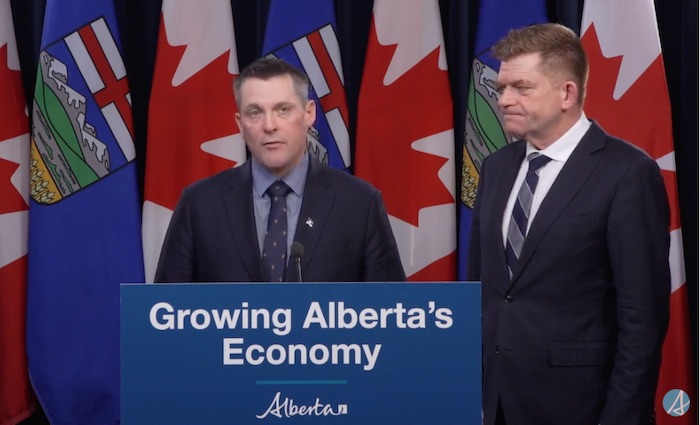Agriculture
Province announces massive commitments to rural Alberta

Building up the rural Alberta economy
Alberta’s government has unveiled a plan to drive economic growth and address challenges unique to rural communities.
Rural Alberta is a driving force in the economy and the new Economic Development in Rural Alberta Plan will complement current government initiatives while supporting diversification and job opportunities in rural communities.
The five-year plan focuses on key issues in rural Alberta, including economic development-enabling infrastructure, rural business supports and entrepreneurship, support for labour force and skills development, marketing and promoting rural tourism, and rural economic development capacity building.
“Rural Albertans face unique economic barriers and challenges that require a different approach than their urban neighbours. The Economic Development in Rural Alberta Plan charts a path forward that will address these issues and build on our commitment in Budget 2022 to support sustainable growth and diversification in rural Alberta.”
As one of the first tangible actions under the plan, the government has committed $125,000 to each of the eight regional economic development alliances to support long-term economic prosperity in their respective regions.
“With strengths in oil and gas, agriculture and forestry, tourism and emerging technologies, Alberta’s rural and northern communities are the backbone of our province’s economy. Actions identified in this plan will benefit rural and northern Albertans for years to come, including providing additional support to Alberta’s network of regional economic development alliances to fuel further economic growth and prosperity across our province.”
The Announcement
Engaging with rural Albertans
The plan was created after a year of consultations. Beginning in fall 2021, Alberta’s government held targeted sessions with rural Alberta businesses and communities, in addition to Indigenous communities, to identify the specific challenges and possible solutions facing their regions.
In total, government hosted 23 virtual engagement sessions with more than 370 rural Albertans, businesses and communities, receiving 3,500 comments. At the same time, an online survey was conducted, which received an additional 919 responses.
Feedback from the sessions and the online survey helped develop the plan’s vision, guiding principles and strategic directions. These were refined and validated through a second phase of targeted engagement with the same individuals and groups in summer 2022.
“Regional economic development alliances are strategically structured to collaborate with governments to address key issues in rural Alberta. Our first step is to identify and improve economic development and enable infrastructure to support investment and growth in rural Alberta. Once we initiate this step, we can further support rural businesses, increase the labour force and market a stronger rural Alberta to Canada and the rest of the world. We look forward to moving forward with the Economic Development in Rural Alberta Plan and continued collaboration with the Government of Alberta.”
“As a leading advocate for our province’s towns and villages, Alberta Municipalities is pleased to see the provincial government focus on the unique needs of Alberta’s smaller and more remote communities. We welcome efforts to grow and diversify our province’s economy, including renewed support for regional economic development alliances.”
“For well over a century the Rural Municipalities of Alberta has helped rural municipalities achieve strong, effective, local government. The Economic Development in Rural Alberta Plan supports our mission to strengthen rural Alberta and cultivate strategic and collaborative partnerships. This plan starts today and is designed for the rural Alberta of tomorrow.”
Quick facts
- The plan focuses on five key strategic directions:
- Identifying and improving economic development-enabling infrastructure to support investment and growth in rural Alberta.
- Advancing entrepreneurship capacity and a culture of innovation across rural Alberta.
- Enabling skills development in rural communities to enhance workforce capacity today and for the future.
- Enhancing rural Alberta’s reputation and capacity as a diverse tourism destination.
- Enhancing rural economic development through regional and targeted capacity building.
- The plan will complement a number of initiatives that demonstrate the government’s commitment to building healthy and prosperous communities across rural Alberta, including:
- Up to $390 million over four years as part of the Alberta Broadband Strategy to eliminate the digital divide for all Albertans.
- Nearly $933 million for irrigation infrastructure in partnership with nine irrigation districts to expand and modernize Alberta’s irrigation infrastructure.
- $78 million to fund 133 active capital maintenance and renewal projects in rural Alberta communities.
- A $59-million investment to expand veterinary medicine at the University of Calgary, doubling the number of seats in the program to address a critical shortage of large animal veterinarians in rural Alberta.
- $70 million for the Film and Television Tax Credit that will attract major productions to the province, diversifying the economy and creating thousands of new jobs.
- More than $8 million through the Indigenous Opportunities Corporation to support Indigenous communities’ participation in commercially viable resource projects to support rural economic growth.
Agriculture
Lacombe meat processor scores $1.2 million dollar provincial tax credit to help expansion

Alberta’s government continues to attract investment and grow the provincial economy.
The province’s inviting and tax-friendly business environment, and abundant agricultural resources, make it one of North America’s best places to do business. In addition, the Agri-Processing Investment Tax Credit helps attract investment that will further diversify Alberta’s agriculture industry.
Beretta Farms is the most recent company to qualify for the tax credit by expanding its existing facility with the potential to significantly increase production capacity. It invested more than $10.9 million in the project that is expected to increase the plant’s processing capacity from 29,583 to 44,688 head of cattle per year. Eleven new employees were hired after the expansion and the company plans to hire ten more. Through the Agri-Processing Investment Tax Credit, Alberta’s government has issued Beretta Farms a tax credit of $1,228,735.
“The Agri-Processing Investment Tax Credit is building on Alberta’s existing competitive advantages for agri-food companies and the primary producers that supply them. This facility expansion will allow Beretta Farms to increase production capacity, which means more Alberta beef across the country, and around the world.”
“This expansion by Beretta Farms is great news for Lacombe and central Alberta. It not only supports local job creation and economic growth but also strengthens Alberta’s global reputation for producing high-quality meat products. I’m proud to see our government supporting agricultural innovation and investment right here in our community.”
The tax credit provides a 12 per cent non-refundable, non-transferable tax credit when businesses invest $10 million or more in a project to build or expand a value-added agri-processing facility in Alberta. The program is open to any food manufacturers and bio processors that add value to commodities like grains or meat or turn agricultural byproducts into new consumer or industrial goods.
Beretta Farms’ facility in Lacombe is a federally registered, European Union-approved harvesting and meat processing facility specializing in the slaughter, processing, packaging and distribution of Canadian and United States cattle and bison meat products to 87 countries worldwide.
“Our recent plant expansion project at our facility in Lacombe has allowed us to increase our processing capacities and add more job opportunities in the central Alberta area. With the support and recognition from the Government of Alberta’s tax credit program, we feel we are in a better position to continue our success and have the confidence to grow our meat brands into the future.”
Alberta’s agri-processing sector is the second-largest manufacturing industry in the province and meat processing plays an important role in the sector, generating millions in annual economic impact and creating thousands of jobs. Alberta continues to be an attractive place for agricultural investment due to its agricultural resources, one of the lowest tax rates in North America, a business-friendly environment and a robust transportation network to connect with international markets.
Quick facts
- Since 2023, there are 16 applicants to the Agri-Processing Investment Tax Credit for projects worth about $1.6 billion total in new investment in Alberta’s agri-processing sector.
- To date, 13 projects have received conditional approval under the program.
- Each applicant must submit progress reports, then apply for a tax credit certificate when the project is complete.
- Beretta Farms has expanded the Lacombe facility by 10,000 square feet to include new warehousing, cooler space and an office building.
- This project has the potential to increase production capacity by 50 per cent, thereby facilitating entry into more European markets.
Related information
Agriculture
Unstung Heroes: Canada’s Honey Bees are not Disappearing – They’re Thriving

Canada’s Bee Apocalypse began in 2008. That was the year the Canadian Association of Professional Apiculturists (CAPA) first reported unusually high rates of winter bee colony losses. At 35 percent, the winter die-off that year was more than twice the normal 15 percent rate of attrition.
“Successive annual losses at [these] levels … are unsustainable by Canadian beekeepers,” the CAPA warned. This set off an avalanche of dire media reports that now appear on a regular basis. Among the many examples over the years: Huge Honey Bee Losses Across Canada” and “Canada’s bee colonies see worst loss in 20 years”. As each of these stories reminds readers, the disappearance of honey bees will doom our food supply, given their crucial role in pollinating crops including canola, soyabeans, apples, tomatoes and berries.
This year the black-and-yellow striped Cassandras are back at work, with headlines shouting “Scientists warn of severe honeybee losses in 2025” and “The Bees are Disappearing Again”. If it’s spring, the bees must be disappearing. Again.
It is, however, mathematically impossible for any species to be in an allegedly continuous and calamitous state of decline over nearly two decades and never actually reduce in number. For despite the steady supply of grave warnings regarding their imminent collapse, Canada’s bees are actually buzzing with life.
In 2007, according to Statistics Canada, there were 589,000 honey bee colonies in Canada,; in 2024, they reached 829,000, just shy of 2021’s all-time high of 834,000. Figuring a conservative summertime average of 50,000 bees per colony, that means there are approximately 12 billion more honey bees in Canada today than when the Bee Apocalypse first hit.
As for beekeepers, their numbers have also been growing steadily, and now stand at 15,430 – the most recorded since 1988. As CAPA’s report acknowledges, “the Canadian beekeeping industry has been resilient and able to grow, as proven by the overall increase in the number of bee colonies since 2007 despite the difficulties faced every winter.”
How is this possible? As is usually the case where there’s a need to be filled, the market holds the answer.
It is true that Canadian honey bees face a long list of threats and challenges ranging from mites and viruses to Canada’s harsh winters. It is also true that they perform a crucial service in pollinating crops, the value of which is estimated at $7 billion annually. However, this underscores the fact that bees are a livestock bred for a particular agricultural purpose, no different from cattle, chickens or pen-raised salmon. They are a business.
And in spite of its alleged status as an environmental totem, the honey bee isn’t even native to North America. It was first imported by European settlers for its honey-making abilities in the 1600s. Since then, it has been cultivated with deliberate commercial intent – allowing it to outcompete native pollinators such as bumble bees and butterflies even though it is poorly suited to the local winter. (This highlights the irony of all those native-plant pollinator gardens virtuously installed in neighbourhoods across Canada that end up supporting an invasive honey bee population.)
The significance of the bee economy means that when a beehive collapses over the winter for whatever reason, beekeepers have plenty of motivation to regenerate that colony as swiftly as possible. While hives can create their own queens over time, this can be a slow process given the cold Canadian climate. The better option is to simply buy a new queen from a warmer country.
In 2024, Canada imported 300,000 queens worth $12 million, mostly from the U.S., Italy, Australia and Chile. That works out to $40 each. In a miracle of nature, each of these new queens can lay up to 2,500 eggs a day, and each egg takes just two to three weeks to reach full maturity as a worker or drone. It is also possible to import entire “bee packages” that include a queen and 8,000 to 10,000 bees.
As a result, even a devastating 50 percent winter loss rate, something that has occurred only rarely in Canada in individual provinces and never nationally, isn’t necessarily fatal to any beekeeping operation. The beekeeper can purchase imported queens in April, split their existing colonies and be back in business by May or June.
And regardless of the honey bee’s apparent difficulties with Canada’s unforgiving weather (efforts are ongoing to breed a hardier Canadian variant), there’s no shortage of bees worldwide. Earlier this year, the German statistical agency reported the global beehive count rose from 69 million in 1990 to 102 million in 2023. Another study looking back to 1961 by New Zealand researchers found the number of honey bee colonies has “nearly doubled” over this time, while honey production has “almost tripled.” As the New Zealand report observes, “Headlines of honey bee colony losses have given an
impression of large-scale global decline of the bee population that endangers beekeeping, and that the world is on the verge of mass starvation.” Such claims, the authors note, are “somewhat inaccurate.” In truth, things have never been better for bees around the world.
Here in Canada, the ability to import queens from other countries, together with their prodigious reproductive capabilities, backstops the amazing resiliency of the bee industry. Yes, bees die. Sometimes in large numbers. But – and this is the bit the headlines always ignore – they come back. Because the market needs them to come back.
If there is a real threat to Canada’s bee population, it’s not environmental. It’s the risk that unencumbered trade in bees might somehow be disrupted by tariffs or similar bone-headed human interventions. Left on their own, bees have no problem keeping busy.
The longer, original version of this story first appeared at C2CJournal.ca
-

 Business1 day ago
Business1 day agoMark Carney’s Fiscal Fantasy Will Bankrupt Canada
-

 Opinion1 day ago
Opinion1 day agoCharity Campaigns vs. Charity Donations
-

 Alberta1 day ago
Alberta1 day agoTemporary Alberta grid limit unlikely to dampen data centre investment, analyst says
-

 Daily Caller22 hours ago
Daily Caller22 hours ago‘Strange Confluence Of Variables’: Mike Benz Wants Transparency Task Force To Investigate What Happened in Butler, PA
-

 Frontier Centre for Public Policy2 days ago
Frontier Centre for Public Policy2 days agoCanada’s New Border Bill Spies On You, Not The Bad Guys
-

 Uncategorized2 days ago
Uncategorized2 days agoCNN’s Shock Climate Polling Data Reinforces Trump’s Energy Agenda
-

 Opinion1 day ago
Opinion1 day agoPreston Manning: Three Wise Men from the East, Again
-

 Business1 day ago
Business1 day agoCarney Liberals quietly award Pfizer, Moderna nearly $400 million for new COVID shot contracts


